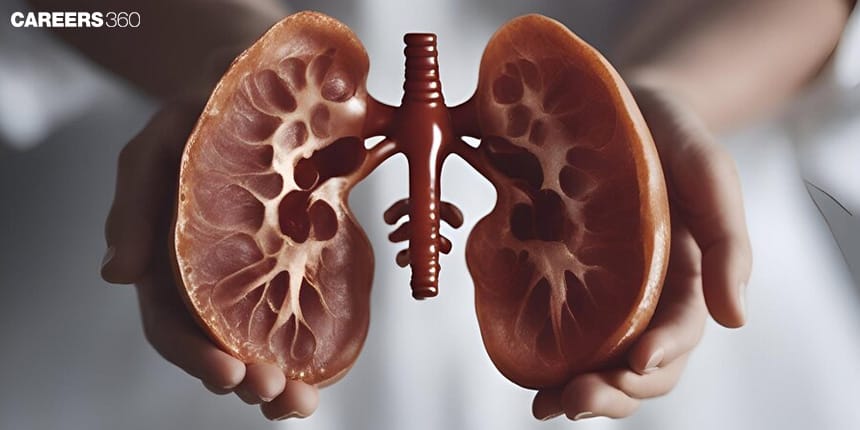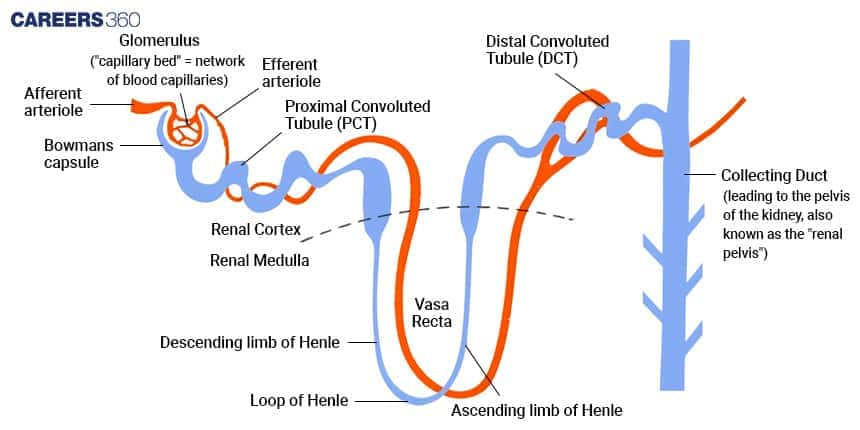Counter Current Mechanism: Introduction, Formation, Steps, And Composition
The countercurrent mechanism in the kidney works critically in concentrating the filtrate and conserving water. It works by the collaboration between the descending and ascending limbs of the loop of Henle where fluid flows in opposite directions. The countercurrent flow sets up an osmotic gradient in the renal medulla, which proves critical for reabsorbing water and solutes. As the fluid moves through the descending limb, this limb reabsorbs water, concentrating the fluid further. In contrast, through the ascending limb, active reabsorption of sodium and potassium ions and chloride ions makes the fluid hypotonic. This countercurrent mechanism allows the kidney to obtain a high osmotic gradient that is extremely important for efficiently concentrating the urine and maintaining the balance in body fluids. This is part of Excretory Products And Their Elimination in Biology.
NEET 2025: Mock Test Series | Syllabus | High Scoring Topics | PYQs
NEET Important PYQ's Subject wise: Physics | Chemistry | Biology
New: Meet Careers360 B.Tech/NEET Experts in your City | Book your Seat now
- Counter-Current Mechanism
- Concurrent Flow Vs. Countercurrent Flow
- Steps of the Countercurrent Mechanism
- Concentrated Urine Formation
- Major Parts of a Nephron

Counter-Current Mechanism
The countercurrent mechanism is an essential procedure in the kidney that enables urination to become concentrated by retaining water. It has established an osmotic gradient in the renal medulla, where the water reabsorption from the tubular fluid back into the bloodstream accompanies the excretion of excess solutes. Thus, it ensures there is a proper fluid balance in the body and generates concentrated urine.
Also Read:
Concurrent Flow Vs. Countercurrent Flow
The countercurrent mechanism is a process in which two fluids move or flow in opposite directions to facilitate the exchange of substances between themselves. For example, two tubes carrying solutions made of the same solute would be they are kept in open communication so as to facilitate some exchange of substances. Major types of flow patterns
Concurrent Flow: Both solutions in the two tubes flow in the same direction. For example, if one tube starts with 0% concentration and the other with 100% concentration, at the time they will have reached the opposite ends, both tubes will have about 50% concentration.
Countercurrent Flow: The solutions in the two tubes flow in opposite directions. In this experiment, one tube contains a solution with 0% concentration at one end, while the other contains a solution with 100% concentration at the other end. Solutions then flow in each tube to reach the middle, and it is when they meet in the middle that the substances are transferred, so at the other end, each tube's concentrations are now closer and thus maintain the efficient exchange.
Since there is free exchange of substances between the tubes, by the time they reach the end, the solutions will have picked up a concentration equal to that in the other tube.
Steps of the Countercurrent Mechanism
The countercurrent mechanism in the kidney is concerned with the cooperation between the descending limb and ascending limb of the loop of Henle. It results in the concentration gradient in the renal medulla that will make water and other solutes efficiently reabsorbed, so the kidneys will be able to concentrate the urine.
Transport in the Thick Ascending Limb of Henle: Sodium, potassium, and chloride ions are all actively reabsorbed. This is the limb in which a hypotonic fluid leaves the tubule. This is an essential process in the establishment of the osmotic gradient in the medulla. The fluid leaving this limb is poor in solutes. Hence it contributes to the gradient for the reabsorption of water.
Equilibration in the Descending Thin Limb: The thin limb of Henle is relatively permeable to water as well as small solutes. Since the tubular fluid becomes more concentrated since water reabsorption creates an area for diffusion of solutes into the fluid, it leads to equilibration of concentration between the fluid and the surrounding interstitial fluid.
Fluid Flow and Osmotic Gradient: New fluid enters the descending limb continuously, pushing more concentrated fluid down the loop of Henle. It has a countercurrent flow that creates a repetitive process in increasing the osmotic gradient. The longer the loop of Henle, the bigger the gradient, which means more effective reabsorption of water.
Countercurrent Mechanism: The countercurrent mechanism works by producing a countercurrent multiplier system in which the flow of fluid in opposite directions in the descending and ascending limbs generates and maintains an osmotic gradient. This gradient allows the concentration of the filtrate, which enables the conservation of water in the body.
It means essentially that in the countercurrent mechanism, the fluid of the descending limb becomes more concentrated and the fluid in the ascending limb becomes more diluted to enhance water reabsorption and concentration of solutes in the kidney.
Concentrated Urine Formation
The countercurrent mechanism concentrates urine through the following steps:
NaCl is transported from the loop of Henle's ascending limb down to the vasa recta's descending limb.
NaCl is then passed on to the interstitium via the ascending limb of the vasa recta from 300 mOsm at the cortex to 1200 mOsm at the medulla.
The role of the descending limb of the loop of Henle is to transport urea into the interstitium, adding to the osmotic gradient. As the urine flows down the collecting tubule, higher concentrations of solutes in the interstitium increase water reabsorption due to osmosis and concentrate the urine.
The mechanism of countercurrent flow, along with countercurrent exchange across the vasa recta, maintains the high osmolarity in the renal medulla. Concentrated urine can then be produced with water conserved.
Major Parts of a Nephron

Glomerulus: Filtrates blood to form filtrate.
Bowman's Capsule: Collects the filtrate from the glomerulus
Proximal Convoluted Tubule: Reabsorbs nutrients, ions, and water.
Loop of Henle: Concentrates urine by the reabsorption of water and salts.
Distal Convoluted Tubule: Fine adjustment in the composition of fluid.
Collecting Duct: Finally concentrates the urine.
Also Read
Recommended video on Counter Current Mechanism
Frequently Asked Questions (FAQs)
Tubular reabsorption changes useful substances back into the blood. On the other hand, tubular secretion adds waste substances to the tubular fluid for excretion.
Water, glucose, amino acids, sodium, potassium, chloride, and bicarbonate are typically reabsorbed.
Aldosterone and other hormones control the transfer of ions. This will shift the makeup and pH of urine.
It could be linked to abnormalities of reabsorption or secretion with disorders such as diabetes mellitus, renal tubular acidosis, or abnormalities in electrolytes.
Also Read
28 Nov'24 08:16 PM
28 Nov'24 06:24 PM
28 Nov'24 12:06 PM
27 Nov'24 04:33 PM
27 Nov'24 02:40 PM
27 Nov'24 12:24 PM